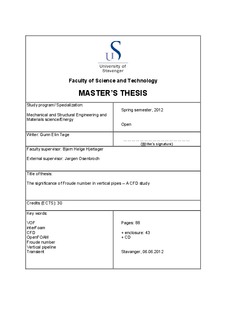| dc.description.abstract | The main objective is to develop a simulation model in OpenFOAM which can be used to study the transition from pressure to gravity driven flow in vertical pipelines. A pump is connected upstream, ensuring pressure driven flow while running. As the pump shuts down and water is drained a transition is expected to occur from pressure driven to gravity driven flow. A release valve is attached at the top of the vertical pipeline. It ensures air is induced as the pressure inside the pipeline decreases below the atmospheric pressure. The standard NORSOK P-001 (2006) recommends that vertical gravity lines shall be sized in accordance to a Froude number less than 0.3. An increased Froude number is expected to cause air entrainment and pulsations. In accordance to Osenbroch (2011) the origin of the design criteria is unknown, and to some extend it appears that a higher Froude number of 0.6-0.7 is used. A literature study shall therefore be performed with respect to relevant theory.
In OpenFOAM a two phase model named interFoam is adopted to study five vertical pipes of 20m height. Four cases are vented while the last is unvented. Three of the cases are associated with a 4" vent, while the main pipe diameter is set to respectively 12", 18" and 24". These changes are expected to indicate how the main pipe diameter affects the flow pattern. The fourth case is an 18" pipeline subjected to a 2" vent. An identical main pipe diameter is simulated without a vent. Three different vent designs of respective 4", 2" and unvented is therefore examined for an identical main pipe diameter of 18". Changes in vent design are expected to affect the flow pattern. The literature review examines the definition of the Froude number and its relationship to physical problems. A relevant topic regarding transient theory is incorporated. Generally it describes how flow is affected by a valve closure. The origin of the Froude number design criterion is also presented according to previous research. However, it is based on a scarce open literature.
Cases subjected to a 4" vent is fully drained during equal time intervals of 2 minutes. However, the total water volume differs due to the main pipe diameter of respectively 12", 18" and 24". Water must therefore drain at an increased flow rate as the main pipe diameter increases. All cases are characterized by a linear pressure decrease subsequent to the pump shut down. The presented transient theory describes this phenomenon. As the pump shuts down, pressure drops close to the pump due to flow retardation. This causes a negative pressure wave to propagate downstream. If pressure is sufficiently decreased vapor bubbles may form, which is also known as flashing. Propagation of a pressure wave is known as water hammer.
The Froude number criterion mentioned in the standard NORSOK P-001 (2006) appears to apply for draining from a process vessel. A Froude number less than 0.3 is recommended to ensure the vertical pipe is running full. If the Froude number is increased beyond 0.3, a weir is formed at the top surface and air is sucked into the liquid flow. However, this theory assumes a considerably wide process vessel. Transient theory seems to apply greater knowledge to future design, than does the Froude number. Water hammer may be the phenomenon which causes vibrations during shut down, rather than oscillations due to air entrainment. Water hammer is caused by abruptly changes in fluid flow, and it is the change in velocity which determines the magnitude of the liner pressure decrease. Rapid changes in flow velocity should therefore be avoided. It must be stated that solutions are found on very coarse meshes, which affects the accuracy of the results. Results are however assumed to indicate how the flow regime transforms and how it is affected by boundary conditions. The pump shut down in the simulation is also too rapid. In reality the flow must decrease during a finite time period. | no_NO |
